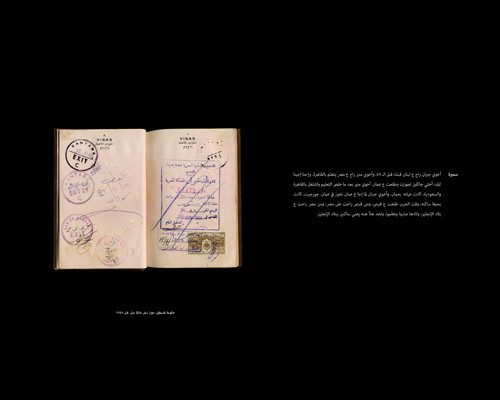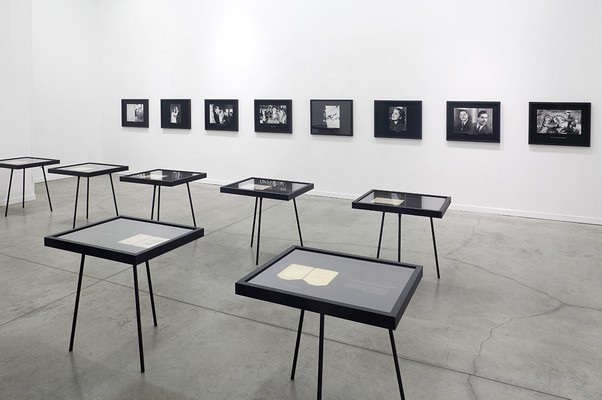Dor Guez - Sabir The archive
22 Dec 2011 - 04 Feb 2012

Dor Guez, Scanograms #2, September 2011, Government of Palestine, Passport, El Monayer Family, before 1948, 2011

Dor Guez, Scanograms #2, September 2011, Government of Palestine, Passport, El Monayer Family, before 1948, 2011
Dor Guez
"Sabir: The Archive"
SABIR: THE ARCHIVE is the second part of an ongoing project about the city of Jaffa. The first part was recently displayed at Dvir Gallery in the Jaffa port.
Sabir comes from the Latin root “to know”, and refers to a vernacular shared by native speakers of many different languages who come in contact with one another. The dialect’s vocabulary draws on all the regional languages, often distorting and reinventing words as they come in contact with the other tongues. The best known of the world’s sabirs is the dialect of Middle Eastern ports, which bears elements of French, Italian, Arabic, Hebrew, Maltese and Spanish. A sabir dialect is a result of a cultural development; it marks a new nation’s arrival. Guez uses the term to introduce the first chapter of his new video piece, which was shown in the exhibition’s first part at Dvir Gallery. The piece’s subject is Samira, whose family was based in Jaffa. Samira’s describes pre-1948 Jaffa, and the subsequent departure of most of the city’s Christian residents, in a mixture of her mother tongue – Arabic – and her later-acquired Hebrew. While most of her childhood memories are recounted in Arabic, the war and its consequences are described in Hebrew. In the background, the sun sets peacefully against the Jaffa beach.
The project’s second part – SABIR: THE ARCHIVE – a study of two thematic series taken from Guez’s Christian-Palestinian Archive, which he has been compiling continually over the past three years. Ongoing and adaptive archiving practices are a major component for producing and forming a culture’s collective identity. Guez’s project is the first archive dedicated to the Christian-Palestinian community, a territorially spread out and disjointed series of communities, for whom Christianity is the common denominator. The archive’s starting point was the artist’s own family's albums, which include testimonies of the life of the Christian-Palestinian minority. Today the archive has grown to include thousands of photographs and documents from the first half of the 20th century, representing communities in Jordan, Syria, Egypt, Israel and Palestine. The project’s main goal is to create an online visual database, which will document and present the community and its history and will be accessible to the general public.
The archive’s first project, Scanograms # 1, includes fifteen images from the life of one woman, dating from the years 1938-1958. Their subject — Samira, Dor Guez’s grandmother — was also the subject of a video piece from the exhibition’s first part. Each image documents an important event of her family’s life before they spread from Jaffa to Lod, Amman, Cyprus, Cairo, and London. Photography in those days was a belabored and planned event, hence the pictures depict landmark moments: a wedding, a passport photo, an image of unexpected snow, and so on. Decades are thus condensed into a number of single frames in a family album, depicting a limited mirror of a long life.
The installation Scanograms # 2 contains nine black wooden objects, each presenting passport pages from the British Mandate of Palestine, before Israel was established. Each of the nine objects is presented alongside written testimonies in Arabic, which the artist has recorded over the past few years as part of the archive project. The visa stamps (from Egypt, Lebanon, Jordan etc.) and the testimonies evoke an image of a very different region than we know today, an open Middle East, with free mobility and open borders. The last stamp in the record is from 1947.
Dor Guez is the recipient of the David Orgler Research fund, 2011, and a lecturer in Bezalel’s department of history and theory. His projects have been shown in Israel and around the world, including Georgiopolis at the Petach-Tikva museum of art, The Monayer Family at the Jewish Museum in New York, Lydd Ruins at the Museum for Modern Art, Ljubljana, Al-Lydd at KW Center for Contemporary Art, Berlin, The Nation’s Groves at the Tel Aviv Museum of Art and Carlier Gebauer Gallery, Berlin, Against the Grain at Beursschouwburg, Brussels, Scanograms #2 at the 12th Istanbul Biennial, Watermelons under the Bed at the 17th São Paulo video biennial, and more. SABIR is his first solo exhibition at Dvir Gallery.
"Sabir: The Archive"
SABIR: THE ARCHIVE is the second part of an ongoing project about the city of Jaffa. The first part was recently displayed at Dvir Gallery in the Jaffa port.
Sabir comes from the Latin root “to know”, and refers to a vernacular shared by native speakers of many different languages who come in contact with one another. The dialect’s vocabulary draws on all the regional languages, often distorting and reinventing words as they come in contact with the other tongues. The best known of the world’s sabirs is the dialect of Middle Eastern ports, which bears elements of French, Italian, Arabic, Hebrew, Maltese and Spanish. A sabir dialect is a result of a cultural development; it marks a new nation’s arrival. Guez uses the term to introduce the first chapter of his new video piece, which was shown in the exhibition’s first part at Dvir Gallery. The piece’s subject is Samira, whose family was based in Jaffa. Samira’s describes pre-1948 Jaffa, and the subsequent departure of most of the city’s Christian residents, in a mixture of her mother tongue – Arabic – and her later-acquired Hebrew. While most of her childhood memories are recounted in Arabic, the war and its consequences are described in Hebrew. In the background, the sun sets peacefully against the Jaffa beach.
The project’s second part – SABIR: THE ARCHIVE – a study of two thematic series taken from Guez’s Christian-Palestinian Archive, which he has been compiling continually over the past three years. Ongoing and adaptive archiving practices are a major component for producing and forming a culture’s collective identity. Guez’s project is the first archive dedicated to the Christian-Palestinian community, a territorially spread out and disjointed series of communities, for whom Christianity is the common denominator. The archive’s starting point was the artist’s own family's albums, which include testimonies of the life of the Christian-Palestinian minority. Today the archive has grown to include thousands of photographs and documents from the first half of the 20th century, representing communities in Jordan, Syria, Egypt, Israel and Palestine. The project’s main goal is to create an online visual database, which will document and present the community and its history and will be accessible to the general public.
The archive’s first project, Scanograms # 1, includes fifteen images from the life of one woman, dating from the years 1938-1958. Their subject — Samira, Dor Guez’s grandmother — was also the subject of a video piece from the exhibition’s first part. Each image documents an important event of her family’s life before they spread from Jaffa to Lod, Amman, Cyprus, Cairo, and London. Photography in those days was a belabored and planned event, hence the pictures depict landmark moments: a wedding, a passport photo, an image of unexpected snow, and so on. Decades are thus condensed into a number of single frames in a family album, depicting a limited mirror of a long life.
The installation Scanograms # 2 contains nine black wooden objects, each presenting passport pages from the British Mandate of Palestine, before Israel was established. Each of the nine objects is presented alongside written testimonies in Arabic, which the artist has recorded over the past few years as part of the archive project. The visa stamps (from Egypt, Lebanon, Jordan etc.) and the testimonies evoke an image of a very different region than we know today, an open Middle East, with free mobility and open borders. The last stamp in the record is from 1947.
Dor Guez is the recipient of the David Orgler Research fund, 2011, and a lecturer in Bezalel’s department of history and theory. His projects have been shown in Israel and around the world, including Georgiopolis at the Petach-Tikva museum of art, The Monayer Family at the Jewish Museum in New York, Lydd Ruins at the Museum for Modern Art, Ljubljana, Al-Lydd at KW Center for Contemporary Art, Berlin, The Nation’s Groves at the Tel Aviv Museum of Art and Carlier Gebauer Gallery, Berlin, Against the Grain at Beursschouwburg, Brussels, Scanograms #2 at the 12th Istanbul Biennial, Watermelons under the Bed at the 17th São Paulo video biennial, and more. SABIR is his first solo exhibition at Dvir Gallery.






